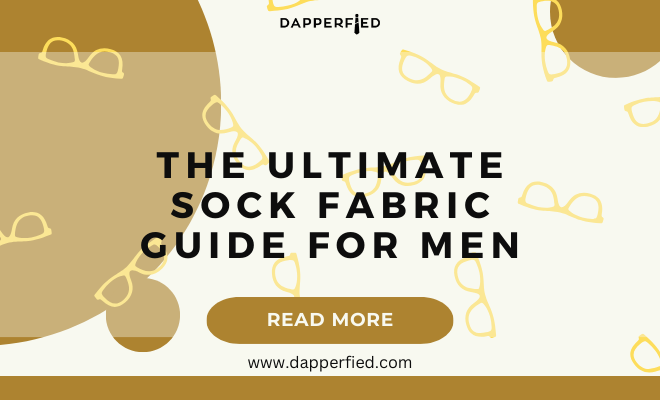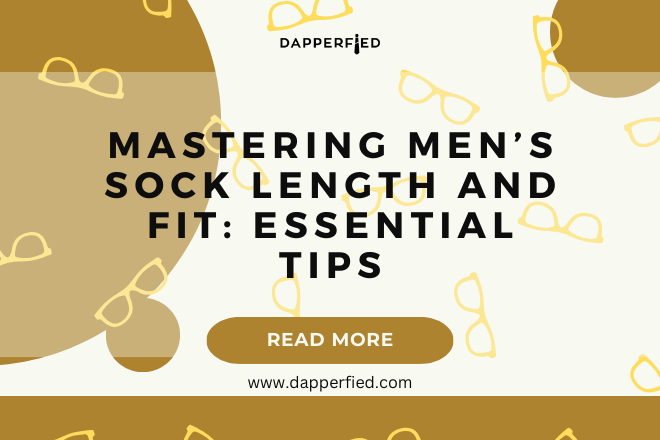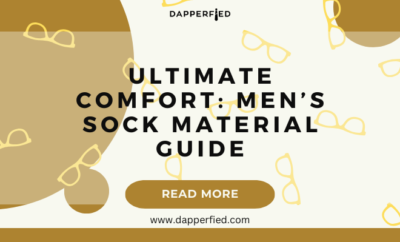
Men's Style
The Ultimate Sock Fabric Guide for Men
When selecting socks, it is important to understand the characteristics of different fabric options. Cotton is a common choice, offering breathability and softness suitable for everyday wear. Wool socks provide excellent insulation and moisture-wicking properties, making them ideal for cold weather and outdoor activities.
Bamboo fabric is known for its antibacterial qualities, moisture-wicking abilities, and softness, making it suitable for those with sensitive skin. Synthetic materials like polyester and nylon are often used in athletic socks due to their durability, moisture-wicking capabilities, and quick-drying properties. These fabrics are particularly well-suited for intense physical activities.
By understanding the unique properties of each fabric type, consumers can make informed decisions when choosing socks that best meet their specific needs and preferences.
Key Takeaways
- Different sock fabrics offer varying levels of breathability, moisture-wicking, and insulation.
- Choose wool or cashmere for warmth, cotton for breathability, and synthetic blends for durability and stretch.
- Look for sock fabrics that are both durable and comfortable, such as merino wool or bamboo.
- Natural fibers like cotton and wool offer breathability and moisture-wicking properties, while synthetic fibers provide durability and stretch.
- Consider merino wool for cold climates, cotton for warm weather, and bamboo for its moisture-wicking properties.
Choosing the Right Fabric for Different Occasions
Formal and Professional Settings
For formal or professional events, it’s best to opt for dress socks made from natural fibers such as cotton or wool. These fabrics provide a polished and sophisticated look while offering comfort and breathability throughout the day.
Casual Occasions
For casual occasions, cotton or bamboo socks are great options as they are comfortable and versatile. They can be worn with sneakers, loafers, or even sandals, making them a practical choice for everyday wear.
Athletic Activities and Outdoor Pursuits
For athletic activities, synthetic fabrics such as polyester and nylon are the go-to choices. These materials offer excellent moisture-wicking properties and durability, making them ideal for intense workouts or sports. Wool socks are also a great option for outdoor activities in colder weather, providing insulation and warmth while keeping your feet dry.
Durability and Comfort: What to Look for in Sock Fabrics
When it comes to durability and comfort, there are several factors to consider when choosing the right sock fabric. Natural fibers such as cotton, wool, and bamboo are known for their softness and breathability, providing comfort throughout the day. These materials also offer good moisture-wicking properties, keeping your feet dry and comfortable in various conditions.
Additionally, natural fibers are often more durable than synthetic fabrics, making them a long-lasting investment. Synthetic fabrics such as polyester and nylon are valued for their durability and quick-drying properties, making them ideal for athletic activities. They are also resistant to shrinking and stretching, ensuring that your socks maintain their shape and fit over time.
When choosing the right sock fabric, it’s important to prioritize both comfort and durability to ensure that your socks can withstand daily wear and various activities without compromising on comfort.
Natural fibers such as cotton, wool, and bamboo offer several benefits over synthetic fibers when it comes to sock fabrics. Cotton is a breathable and soft material that is gentle on the skin, making it a comfortable choice for everyday wear. It is also hypoallergenic, making it suitable for those with sensitive skin.
Wool is another natural fiber that provides excellent insulation and moisture-wicking properties, keeping your feet warm and dry in colder weather. It is also naturally odor-resistant, making it a practical choice for outdoor activities. Bamboo is a sustainable and eco-friendly option that offers antibacterial properties and moisture-wicking abilities.
It is also incredibly soft and comfortable, making it a popular choice for those seeking luxurious socks. On the other hand, synthetic fibers such as polyester and nylon are valued for their durability and quick-drying properties, making them ideal for athletic activities. They are also resistant to shrinking and stretching, ensuring that your socks maintain their shape and fit over time.
While both natural and synthetic fibers offer unique benefits, understanding their properties can help you make an informed decision based on your specific needs.
Sock Fabrics for Different Climates and Seasons

| Climate/Season | Fabric Type | Features |
|---|---|---|
| Hot and Humid | Cotton | Breathable and moisture-wicking |
| Cold and Dry | Wool | Insulating and moisture-wicking |
| Mild and Variable | Merino Wool | Temperature regulating and moisture-wicking |
| Wet and Rainy | Synthetic Blends | Quick-drying and water-resistant |
Choosing the right sock fabric for different climates and seasons is essential to ensure comfort and protection for your feet. In warmer weather, breathable fabrics such as cotton and bamboo are ideal choices as they help keep your feet cool and dry. These materials offer good moisture-wicking properties, preventing sweat buildup and discomfort during hot days.
Additionally, bamboo socks are naturally antibacterial, making them a great option for preventing odor in warmer climates. For colder weather, wool socks are the preferred choice due to their excellent insulation properties. Wool is known for its ability to retain heat while wicking away moisture, keeping your feet warm and dry in chilly conditions.
It is also naturally odor-resistant, making it a practical choice for outdoor activities in colder climates. Synthetic fabrics such as polyester and nylon are also suitable for various climates due to their quick-drying properties and durability, making them versatile options for different seasons. By considering the specific climate and season, you can choose the right sock fabric that provides optimal comfort and protection for your feet.
Caring for Your Socks: Maintenance and Washing Tips
Caring for Natural Fiber Socks
When it comes to natural fiber socks such as cotton, wool, and bamboo, it’s important to follow the care instructions on the label to prevent shrinking or damage. Cotton socks can typically be machine washed in cold water and tumble dried on low heat, while wool socks may require hand washing or gentle machine washing with a mild detergent.
Caring for Bamboo Socks
Bamboo socks can usually be machine washed on a gentle cycle with cold water, but it’s best to air dry them to maintain their softness and shape.
Caring for Synthetic Fiber Socks and General Tips
Synthetic fiber socks made from polyester or nylon are generally more durable and can withstand machine washing in cold water with regular detergent. It’s important to avoid using bleach or fabric softeners as they can damage the fibers of the socks. By following the recommended care instructions for each type of sock fabric, you can ensure that your socks remain in good condition and provide long-lasting comfort.
Top Sock Fabric Recommendations for Men’s Everyday Wear
For men’s everyday wear, there are several top sock fabric recommendations that offer both comfort and style. Cotton socks are a classic choice that provides breathability and softness, making them suitable for daily activities and casual wear. They come in a variety of colors and patterns, allowing men to express their personal style while staying comfortable throughout the day.
Wool socks are another great option for everyday wear, especially during colder weather. They offer excellent insulation and moisture-wicking properties, keeping feet warm and dry in various conditions. Wool socks also come in a range of styles from dressy to casual, making them versatile for different occasions.

Bamboo socks are a luxurious option that provides exceptional softness and antibacterial properties, making them ideal for men with sensitive skin or those seeking a more indulgent sock experience. For athletic activities or intense workouts, synthetic fiber socks made from polyester or nylon are recommended due to their durability and moisture-wicking abilities. They offer excellent support and comfort during physical activities while maintaining their shape and fit over time.
In conclusion, understanding the different sock fabrics available is essential when choosing the right pair of socks for various occasions. Whether it’s for everyday wear, athletic activities, or different climates, there are specific fabric recommendations that offer both comfort and functionality. By considering factors such as durability, comfort, climate suitability, and maintenance tips, men can make informed decisions when selecting the best sock fabrics for their needs.
If you’re looking for more tips on men’s fashion, check out this article on sought-after Italian shoes for men. It’s a great resource for finding the perfect footwear to complement your sock fabric choices.
FAQs
What are the different types of sock fabrics for men?
There are several types of sock fabrics for men, including cotton, wool, bamboo, and synthetic materials such as polyester and nylon.
What are the benefits of cotton socks?
Cotton socks are breathable, soft, and comfortable. They are also absorbent, making them a good choice for everyday wear.
What are the benefits of wool socks?
Wool socks are known for their warmth and moisture-wicking properties. They are a great choice for cold weather and outdoor activities.
What are the benefits of bamboo socks?
Bamboo socks are eco-friendly, hypoallergenic, and have natural antibacterial properties. They are also soft and breathable, making them a popular choice for those with sensitive skin.
What are the benefits of synthetic socks?
Synthetic socks, such as those made from polyester and nylon, are durable, quick-drying, and often have moisture-wicking properties. They are a good choice for athletic activities.
How should I care for my sock fabrics?
It is important to follow the care instructions on the label of your socks. In general, most sock fabrics can be machine washed and dried, but some may require special care such as air drying or low heat.


















